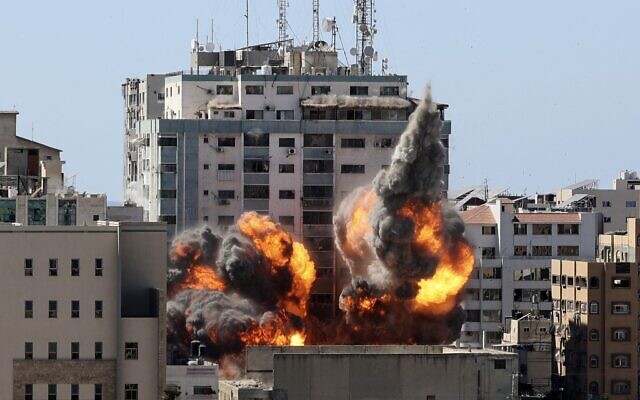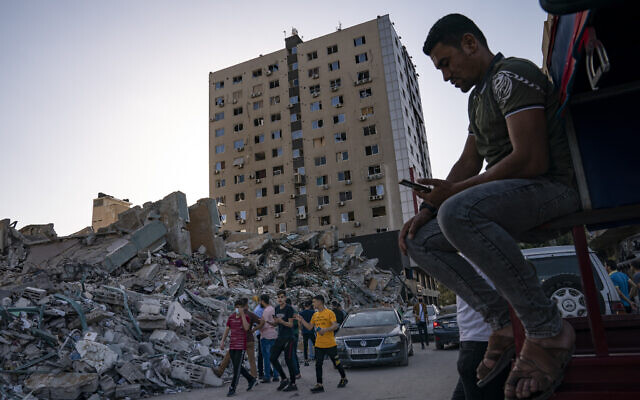NY-based group accuses IDF of damaging neighboring buildings, leaving dozens homeless and destroying scores of businesses; Israel has said building was Hamas military asset
By AGENCIES and TOI STAFF
Today,

Fire and smoke rise from the al-Jalaa Tower as it is destroyed in an Israeli airstrike after the IDF warned the occupants to leave, Gaza City, May 15, 2021. (MAHMUD HAMS / AFP)
Israeli airstrikes that demolished four high-rise buildings in the Gaza Strip during the war in May apparently violated international laws of war, a leading international human rights group said Monday, calling on the Israeli military to produce evidence justifying the attacks.
Human Rights Watch noted that although no one was harmed in the airstrikes, the attacks damaged neighboring buildings, left dozens of people homeless and destroyed scores of businesses.
“The apparently unlawful Israeli strikes on four high-rise towers in Gaza City caused serious, lasting harm for countless Palestinians who lived, worked, shopped or benefited from businesses based there,” said Richard Weir, crisis and conflict researcher for Human Rights Watch. “The Israeli military should publicly produce the evidence that it says it relies on to carry out these attacks.”
The Israeli military did not immediately respond to the report. But it has accused the Hamas terror group of using the buildings for military purposes and turning their occupants into human shields.
It was the New York-based group’s third report on the 11-day war. It has previously accused Israel of apparent war crimes for attacks that it said had no clear military targets but killed dozens of civilians. It also has said that Hamas’ rockets were fired indiscriminately at Israeli cities, constituting a war crime. Both sides denied the accusations.

Fire and smoke rise from the al-Jalaa Tower as it is destroyed in an Israeli airstrike after the IDF warned the occupants to leave, Gaza City, May 15, 2021. (MAHMUD HAMS / AFP)
Israeli airstrikes that demolished four high-rise buildings in the Gaza Strip during the war in May apparently violated international laws of war, a leading international human rights group said Monday, calling on the Israeli military to produce evidence justifying the attacks.
Human Rights Watch noted that although no one was harmed in the airstrikes, the attacks damaged neighboring buildings, left dozens of people homeless and destroyed scores of businesses.
“The apparently unlawful Israeli strikes on four high-rise towers in Gaza City caused serious, lasting harm for countless Palestinians who lived, worked, shopped or benefited from businesses based there,” said Richard Weir, crisis and conflict researcher for Human Rights Watch. “The Israeli military should publicly produce the evidence that it says it relies on to carry out these attacks.”
The Israeli military did not immediately respond to the report. But it has accused the Hamas terror group of using the buildings for military purposes and turning their occupants into human shields.
It was the New York-based group’s third report on the 11-day war. It has previously accused Israel of apparent war crimes for attacks that it said had no clear military targets but killed dozens of civilians. It also has said that Hamas’ rockets were fired indiscriminately at Israeli cities, constituting a war crime. Both sides denied the accusations.
The war erupted on May 10 after Hamas fired a barrage of rockets toward Jerusalem in support of Palestinian protests against Israeli policing at the Temple Mount and against the threatened eviction of dozens of Palestinian families in the Jerusalem neighborhood of Sheikh Jarrah.
(AP Photo/Khalil Hamra)
In all, some 260 people were killed in Gaza, including at least 66 children and 41 women, according to UN figures. Hamas has acknowledged the deaths of 80 terrorists, though Israel says that number is much higher.
Twelve civilians, including two children, were killed in Israel, along with one soldier.
Israel’s destruction of Palestinian high-rises was one of its most controversial wartime tactics. Among the targets was the 12-story al-Jalaa building, which housed the local offices of The Associated Press. The building was also home to dozens of families.
Israel has said the buildings were used by Hamas for military purposes, and in all cases, it ordered occupants to evacuate before the structures were destroyed in what it says was a step to avoid civilian casualties.
The AP has called on Israel to make public the evidence it used to justify the demolition of the al-Jalaa building. Israel has said Hamas terrorists were using the building for a sophisticated effort aimed at disrupting Israel’s Iron Dome rocket-defense system. But it has refused to share its intelligence, saying it did not want to reveal its sources of information.
HRW said it interviewed 18 Palestinians who were either witnesses or victims of the airstrikes. It said it also reviewed video footage and photos after the attacks, as well as statements by Israeli and Palestinian officials and terror groups.
In all, some 260 people were killed in Gaza, including at least 66 children and 41 women, according to UN figures. Hamas has acknowledged the deaths of 80 terrorists, though Israel says that number is much higher.
Twelve civilians, including two children, were killed in Israel, along with one soldier.
Israel’s destruction of Palestinian high-rises was one of its most controversial wartime tactics. Among the targets was the 12-story al-Jalaa building, which housed the local offices of The Associated Press. The building was also home to dozens of families.
Israel has said the buildings were used by Hamas for military purposes, and in all cases, it ordered occupants to evacuate before the structures were destroyed in what it says was a step to avoid civilian casualties.
The AP has called on Israel to make public the evidence it used to justify the demolition of the al-Jalaa building. Israel has said Hamas terrorists were using the building for a sophisticated effort aimed at disrupting Israel’s Iron Dome rocket-defense system. But it has refused to share its intelligence, saying it did not want to reveal its sources of information.
HRW said it interviewed 18 Palestinians who were either witnesses or victims of the airstrikes. It said it also reviewed video footage and photos after the attacks, as well as statements by Israeli and Palestinian officials and terror groups.

People gather to view the rubble of the al-Jalaa building in Gaza City, Friday, May 21, 2021. The building housed The Associated Press bureau in Gaza City for 15 years. (AP/John Minchillo)
It said it found no evidence that terrorists involved in military operations had a current or long-term presence in the buildings when they were attacked. It also said that even if terrorists were using the buildings, making them legitimate targets, Israel is obligated to avoid disproportionate harm to civilians.
“The proportionality of the attack is even more questionable because Israeli forces have previously demonstrated the capacity to strike specific floors or parts of structures,” it said.
The May conflict was the fourth war between Israel and Hamas since the Islamic terror group, which opposes Israel’s existence, seized control of Gaza in 2007, a year after winning Palestinian elections there. Human Rights Watch, other rights groups and UN officials have accused both sides of committing war crimes in all of the conflicts.
Earlier this year, HRW accused Israel of international crimes of apartheid because of discriminatory policies toward Palestinians, both inside Israel as well as in the West Bank and Gaza Strip. Israel has rejected the accusations.
HRW also has called on the International Criminal Court to include the recent Gaza war in its ongoing investigation into possible war crimes by Israel and Palestinian terror groups. Israel does not recognize the court’s jurisdiction and says it is capable of investigating any possible wrongdoing by its army. It says the ICC probe is unfair and politically motivated.

No comments:
Post a Comment